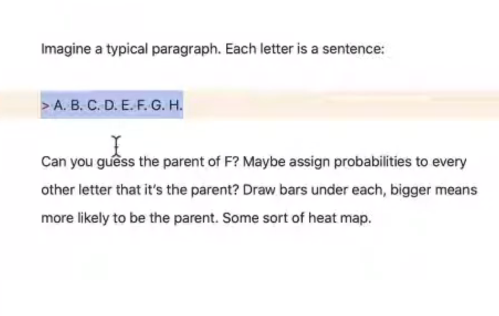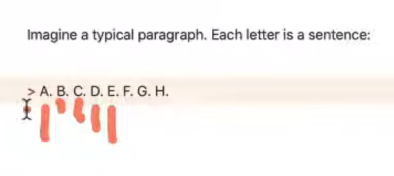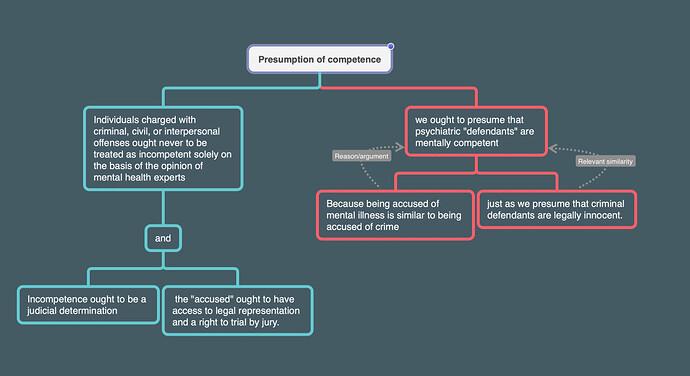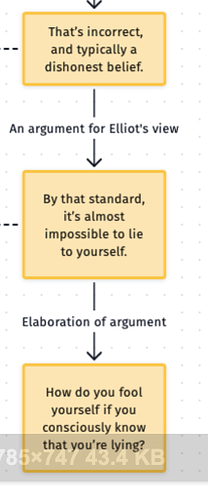Next time I’d suggest aiming for a bit fewer and/or shorter cards. Try to focus on key points more so it isn’t too much work and so lesser points don’t distract from greater ones. If that’s hard, one possibility is to use cards then remove some later after you understand them more.
In Tutoring Max #4, I got up to where the Szasz diagram was gonna be put into a tree and made my own attempt at putting it in a tree or diagram of some kind. The purpose was to try to understand the logical structure. I tried to write down some implied “links” in the argument structure. I’m not super confident about this but figured I’d just take a stab and maybe get some criticism.
I’m not sure about the parts I circled in red. I remember having trouble with this exercise previously. I did it “fresh” without trying to find previous efforts.
Oh here’s the Szasz paragraph for context:
- Presumption of competence. Because being accused of mental illness is similar to being accused of crime, we ought to presume that psychiatric “defendants” are mentally competent, just as we presume that criminal defendants are legally innocent. Individuals charged with criminal, civil, or interpersonal offenses ought never to be treated as incompetent solely on the basis of the opinion of mental health experts. Incompetence ought to be a judicial determination and the “accused” ought to have access to legal representation and a right to trial by jury.
This is what i wound up with after watching most of the Tutoring Max #4 video and trying to do something more in the style of what was being made in that video (though I was pretty hesitant about this tree)
this was Elliot’s tree
how do you think they compare?
The one where I wrote a bunch of implied links was pretty different so I’ll set that to one side for now.
I organized the first sentence the same way as you did in both of my MindNode efforts (the most recent one and the one from a year ago). So the major difference was re: sentences 2 and 3. In my more recent one, I had those sentences structured the same and the main difference from yours was I didn’t nest them underneath other stuff but had them as a more separate point. The mindnode from a year ago was even less structured than that.
So I think overall the difference is that both of my mindnodes are less structured to varying degrees than yours is.
From Tutoring Max #6:

I wasn’t really sure how to assign probabilities. My intuition was that A and E seemed like the most likely places to look. I’ve seen the video before though.
Here’s Elliot’s answer:

I like that exercise. I think I should have put small dots under G and H. People sometimes present stuff out of order. F could also have no parent (be the root), which we might represent as a small dot under itself.
I made a diagram depicting relationships in a paragraph of the Lying essay. This is an exercise in Tutoring Max #6
i hesitated on the direction of the arrows here
I thought maybe they should be pointing up cuz the lower level details are “supporting” the conclusion. OTOH, I thought maybe there should be arrows in both directions cuz the lower level details are elaborating the higher level point. And then there was the view I actually went with, which is that the stuff that’s lower level details is flowing down from/developing the higher level point in some sense, and so the arrows should reflect that relationship.
Anyways I mention all that cuz it’s a detail I sometimes get a bit hung up on in making diagrams/trees like this
Do you need arrow directions at all? What words are they meant to represent?
Good question. I actually had no arrows in one revision too. I’ll think about that some more.
Btw I used the bookmark feature to set up a reminder to make sure I come back to this soon 
I think I was getting mixed up between
- wanting to show parent-child relationships between higher and lower level points
- wanting to indicate that a lower level argument “built up to” higher level stuff
- partially following the flow of the actual writing in the paragraph
so there was like major confusion about what goal I was trying to accomplish, at least with the arrows I pointed out (the arrows indicating contradiction or criticism had clearer goals and I think those were fine)
From the Lying essay:
And if you choose not to consider whether it’s true or false, and then hide your ignorance (from yourself or others), then you’re pretending to have a more reality-based approach to life than you do, and lying about that when you falsely present yourself as knowing more than you do.
(extra bold emphasis added)
I’m not sure what “that” refers to. My natural reading was to locate the reference within “then you’re pretending to have a more reality-based approach to life than you do”. But then that winds up meaning something like “and lying about [pretending to have a more reality-based approach to life than you do] when you falsely present yourself as knowing more than you do.” But I think you wouldn’t actually be lying about pretending to have a more reality-based approach, but about the extent to which you have a reality-based approach.
So then I looked to a more remote part of the sentence. “And if you choose not to consider whether it’s true or false, and then hide your ignorance (from yourself or others),”. Maybe that could refer to ignorance, or hiding your ignorance? I think that’s still not great, cuz 1) it’s a bit far away, 2) the stuff after the “then” seems strongly grouped together, so any back references towards the end of the sentence should refer to stuff within that group.
I wouldn’t even have noticed any issue here if I hadn’t been trying to take the sentence apart to put it in a diagram ![]()
Anyways I might be mistaken here cuz i’m a bit tired but wanted to share
that = “hav[ing] a more reality-based approach to life than you do”
It’s like “You’re pretending to do X and lying about that.” that = X.
It could be written more exactly but I think this is within the sorta ambiguities a charitable reader can figure out. you seemed to get what it meant here: " But I think you wouldn’t actually be lying about pretending to have a more reality-based approach, but about the extent to which you have a reality-based approach." but then after that went and looked for a more obscure meaning.
Yeah I got the idea. It wasn’t unclear or bad writing or anything. I only noticed the issue at all cuz I was trying to break the sentence down into a diagram. I think when I break things down in a more analytical manner I want everything to fit neatly into boxes and be super crystal clear. So it bothers me if stuff doesn’t do that and I notice it way way more than if I was just reading normally.
It’s kind of a mixed bag cuz on the one hand I notice legit problems way more in analytic mode than in passive mode but OTOH I’m also more of a picky pedant about stuff where maybe it doesn’t really matter
i just notice like ALL THE THINGS u know?






